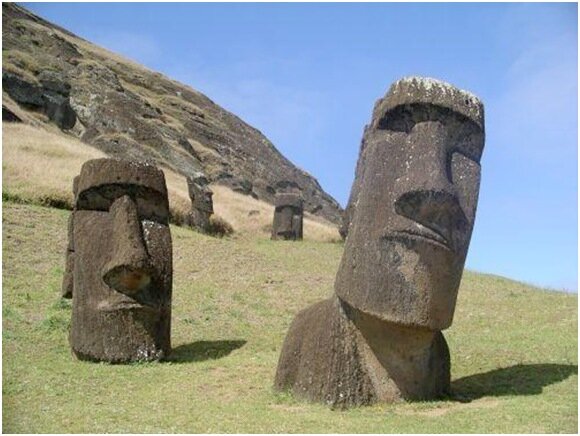Top 10 Inexplicable Stone Structures
Suggested by SMSStonehenge, The Great Pyramids, and the Maoi statues on Easter Island are just a few examples of how ancient man has baffled modern architects, engineers, and archaeologists alike. Huge megalithic temples have been and continue to be discovered which defy our understanding of the intellectual capacities of ancient civilizations. The abilities of ancient man have long been underestimated as shown by these 10 mysterious stone structures.
10. Giant Stone Spheres of Costa Rica

Hundreds of stone spheres have been found scattered in the Diquis Delta of Costa Rica, ranging from a few centimeters to 6 feet in diameter and weighing 16 tons. The spheres are near perfect in shape. Stratigraphy is the only available dating method for these stones, and most of them are no longer in situ, so guesses to their age range from 200 BCE all the way to 1500 CE.
United Fruit Company is responsible for the sphere’s discovery in the 1930s, as they stumbled upon many of them with their bulldozers clearing a location for a banana plantation. Many of the spheres have been damaged by both the heavy equipment, and from sticks of dynamite used to break apart the rocks.
The stones are clouded with mystery. Some theories suggest the Indigenous people had means of softening stones with a magic potion, making the stone’s creation possible. Others are convinced they come from the lost city of Atlantis. Still, some believe the spheres are a creation of nature, without any hand of man in their creation at all.
9. Easter Island Moai

The Moai statues of Easter Island are monolithic human statues carved around 1300 BCE, each weighing around or over 50 tons. Half of the statues are clustered together at the main Moai quarry, while hundreds of others were transported and set around the island’s perimeter.
This feat depicts remarkable creativity and sophistication of the Easter Island people, as some statues are as tall as 33 feet, and others weighing 86 tons.
Oral traditions tell of various individuals with the ability to command the statues to walk at their will with the use of divine power. Many modern attempts to move the Maoi in an upright position, walking them, have failed, due to instability and difficulty navigating rougher terrain. The most successful attempt was moving using sled runners atop log rollers, taking only 25 men two minutes to move a ten-ton replica 150 feet.
8. The Great Pyramid of Giza

The Great Pyramid of Giza is the only surviving of seven cited wonders of the ancient world, and still baffle and impress scholars worldwide. Every ten years or so, the mystery of The Great Pyramid’s construction is allegedly solved, with another engineer or Egyptologist coming to the media with his or her own theory or hypothesis, but as no clear written record exists, these are additionally speculative.
Theories abound from massive slave labor, use of ramps and sleds, kites, the use of harmonics or manipulation of the Earth’s magnetic field, or even alien intervention. The current theory exciting the media is perhaps they were built with ramps spiraling from the inside out, as opposed to the outside in. Evidence of this internal ramp does exist, depicted by a diagram of the pyramid found by the French in a high-tech survey of the pyramids conducted in the 1980s.
7. Stonehenge

A giant prehistoric monument, erected between 3000-2200 BCE, Stonehenge has been a subject of mystery and legend for thousands of years. Folklore suggests they were built by the devil from stones purchased from an Irish woman, and according to Old English Arthurian legend, magician Merlin had the stones removed from Ireland and reconstructed it near Amesbury.
Know one knows exactly the purpose of Stonehenge, but speculations have been made with suggestions as a celestial calendar, burial monument or gateway between life and death, or a ritual place of healing. Because the creators of Stonehenge had no written documentation, knowing the exact function is impossible. The stones were constructed symmetrically, with their axis of symmetry aligned perfectly with the summer and winter solstices.
The bluestones involved in Stonehenge are not indigenous, with the closest natural location being from Wales, transportation for the bluestones from Wales to Amesbury has presented scholars with the mystery of their transportation. Several methods have been tried; proving advanced feats of engineering and that even with an incredibly organized tribe, moving the multiple stones through the densely wooded landscape would have come with tremendous difficulty. One geologist, Aubrey Burl, suggests instead the bluestones were carried to near Amesbury with the help of glacial activity.
6. Nazca Lines

This collection of geoglyphs created with agreement of most scholars by the Nazca culture in Peru date as early as 200 BCE. These shallow sculptures were made with removal of the red pebbles abundant in the Nazca desert revealing the white ground below.
Different geometric designs, with the largest between 650-900 feet across, depict animals, insects, humans, and geometric shapes. While essentially easy to construct using simple tools, the curiosity of the Nazca lines is the large pictures as a whole are only viewable from the sky. Even considering flight was not an option, they must have been created using a very sophisticated sense of mathematical knowledge with very careful planning, as seen by the exactness in the images from above.
Alternative theorists suggest flight may have been possible for the Ancients, either by means of hot air balloon, or advanced technological flight machines. Erik Von Daniken, author of Finger Prints of the Gods, use the Nazca lines as evidence for ancient astronauts.
5. Japanese Under Water Pyramid

Beginning In March of 1995 with excavations continuing to this date, divers off the coast of Okinawa have discovered several structures resembling pyramids, roads, and some semblance of an ancient city.
The most notable of these stone structures is a rectangular ziggurat type structure 90 ft high and 600 ft wide. Smaller pyramids were located nearby. As the area of under water land was last at the surface before it was submerged at end of the most recent ice age, these structures could date to 8000 BCE, 5,000 years older than the oldest recorded pyramid in Egypt.
Many scientists, however, believe natural processes of erosion and splitting rocks could have created the pyramid, and underwater road-like structures created by natural phenomena are not uncommon. While natural erosion is a possibility, examples of natural erosion and rock splitting in the conspicuous sharp nature of these underwater pyramids have not been seen elsewhere in underwater geology.
4. Coral Castle

Coral Castle’s construction commenced in 1920 by Latvian American immigrant Edward Leedskalnin in Florida City, FL. Leedskalnin spent 28 years working on Coral Castle, alone and exclusively at night, not allowing anyone to watch him work.
The castle is constructed completely from oolitic limestone blocks each weighing several tons. The castle is not fastened together using any mortar, simply using the weight of the limestone alone as means to keep the structure together. When a few teenagers reported as being eyewitness, they claimed to witness Leedskalnin levitate the blocks, floating them like balloons.
Leedskalnin asserted he knew the secrets of the pyramids, but never disclosed what these were. He did however, have beliefs contradictory to contemporary science, and believed all matter was made up of magnets and he “rediscovered the laws of weight, measurement, and leverage,” which involved a relationship between celestial alignments and the Earth. Additionally theories include using harmonics as means to move the 30-ton blocks, as scientists and Tibetan monks alike have played with sound as a means for anti gravity.
3. The Sphinx

The Sphinx, partnered alongside The Great Pyramids of Giza, has been a target of mystery for many years. It is commonly supposed among some archaeologists and Egyptologists the Sphinx dates back to the reign of Pharaoh Khafre, circa 2500 BCE.
In the early 90s, however, geological evidence surfaced that dates The Sphinx much earlier than previously speculated. The crux of this evidence revolves around erosion. Erosion by means of water, and that by means of wind and sand, has two very different looking results. The evidence of erosion on The Sphinx points directly to that of water. Not only that, but as some conservative Egyptologists suggest flooding of the Nile as possibility for this water erosion, the heaviest signs come from the top of the body, suggesting heavy rainfall, not the bottom. This evidence possibly dates the Sphinx much earlier than commonly supposed, at 5000-6000 BCE.
Additionally, the head of The Sphinx is disproportionally smaller than the rest of the body, which lead to assumptions that the head was more recently carved from the original structure, possibly in the epoch of original dating at 4500 years ago.
2. Puma Punku and Tiahuanaco

The means of construction at Puma Punku is an engineering anomaly that is not even comprehendible by modern scholars. Presumed current knowledge of the Tiahuanaco culture alludes to no writing system or familiarity with the wheel, the architectural accomplishments at Puma Punku are incredible. The largest of the megalithic stones used in construction is 131 metric tons, and made from red sandstone. The nearest quarry for red sandstone is 10 km away from the archaeological site, and the stones would need to be carried up a steep incline.
The stones are cut with extreme precision to lock together like pieces of a puzzle. Sophisticated knowledge of geometry is exhibited in this construction, as well as advanced masonry. These stones are so meticulously cut they suggest technology of mass production, and they fit together so perfectly even a razor blade cannot fit in between them.
One carved stone at Puma Punku has a perfectly straight line, with drilled, equidistant holes, an impossible feat with copper or stone tools.
Archaeologists argue about the dating of Puma Punku, with claims ranging from to mere 440 CE to more outlandishly 15,000 years old. One thing is for certain, modern engineers still find construction of Puma Punku impossible today, even with the use of our modern day technology and engineering tools.
1. Göbekli Tepe Temple in Turkey

Beginning excavation in 1994, Turkish and German archaeologists are currently uncovering what is now the oldest megalithic monument. Only 5% of this site has currently been excavated, and Archaeologist’s predict it could take another 50 years. So far, it has been dated through the radiocarbon method at 11,000 BCE, predating the pyramids and Stonehenge by over 6,000 years. The pillars of the round stone structure are carved with reliefs of animals including vultures, foxes, lions, gazelles, reptiles, and waterfowl, suggesting the surrounding location of the temple upon construction was far more of a lush landscape than the current conditions of modern day turkey.
This discovery puts a definite spin on the way we view human history, the development of civilization, and the origin of religious practice. It has previously been conceived that man practiced religious ritual post-agriculture, yet bones found at this site clearly suggest a pre-agriculture hunter-gatherer society. Some archaeologists speculate this site, mostly due to its geographic coordinates, as the location of Eden; if not the Biblical Garden itself, than it marks the location to where man made his transition from hunting and gathering to farming, the suggested allegory of the Eden story.
The biggest part of the mystery of Göbekli, however, is that man systematically and deliberately buried the site in around 8000BCE, creating the artificial hills the site was uncovered under.










This was so interesting!
The choral castle is a lot like Axel N. Erlandson's "Tree Circus" in that the secret of how both men accomplished these feats was taken to their graves. This is fascinating stuff though, and proof that the world is still full of mysteries.
Puma Puncu site it is the most amazing by far!
Giant Stone Spheres of Costa Rican might probably have been an attempt to reproduce a scale model of a solar system.
WHAT ARE THE TOLERANCES WE`RE TALKING ABOUT AND HOW ARE THE EXACT MEASURMENTS MADE? ARE THERE ANY INFORMATION AVAILABLE ON THESE? THANKS-EROL
Very good list, they are fascinating. Thanks you for sharing these. Another great addition to the list would be the megalithic temples in Malta, including Hal Saflieni Hypogeum. That was one of my most mmorable trips. They are amazing. There are several links, but this one is pretty good: http://web.infinito.it/utenti/m/malta_mega_temples/index.html
You forgot the ‘stone of the pregnant woman’ – Baalbek, Lebanon
The Nazca lines i belive is answer the pyramids and the waasu circles.it’s like this for what has meaning G/O/D = negative/neutral/positive.
[...] and the Maoi statues on Easter Island are just a few examples of how ancient man has baffled …https://akorra.com/2010/04/06/t ..BBC NEWS | Americas | ‘Brazilian Stonehenge’ discoveredBrazilian archaeologists have [...]
table centerpiece
Top 10 Inexplicable Stone Structures